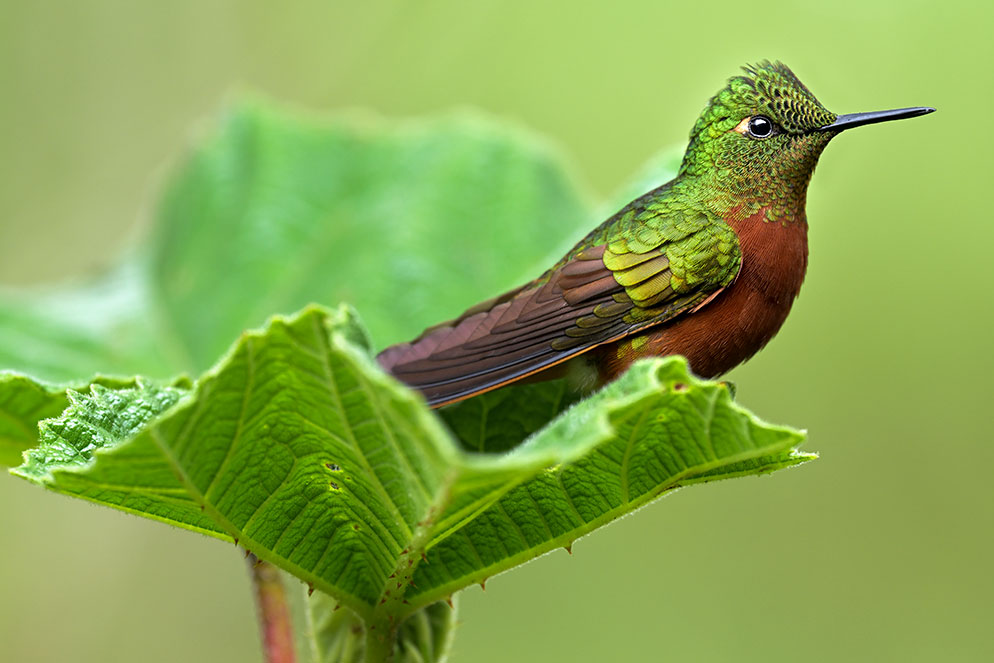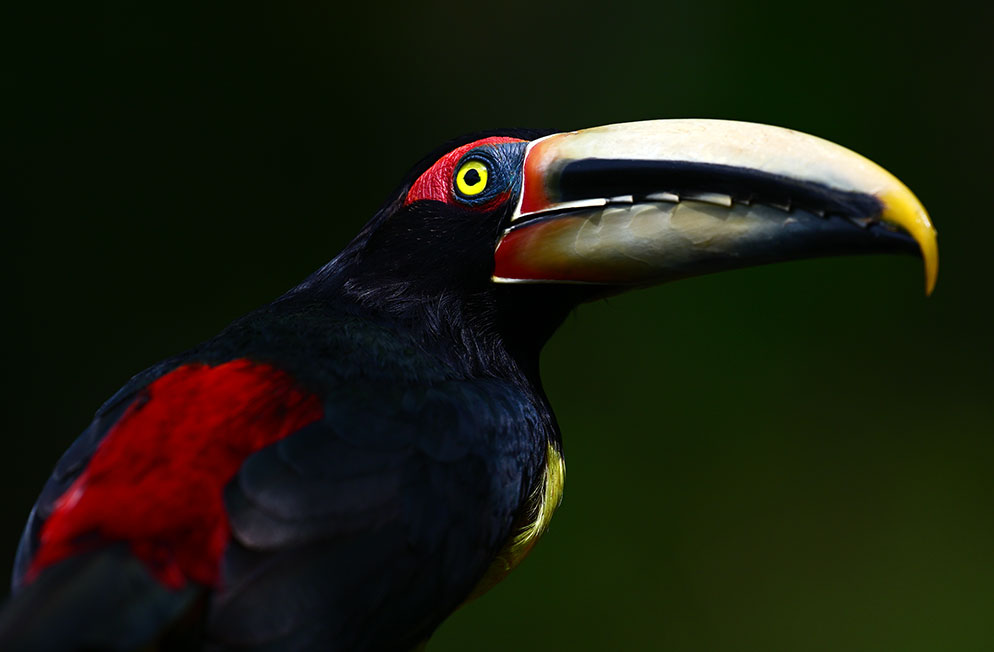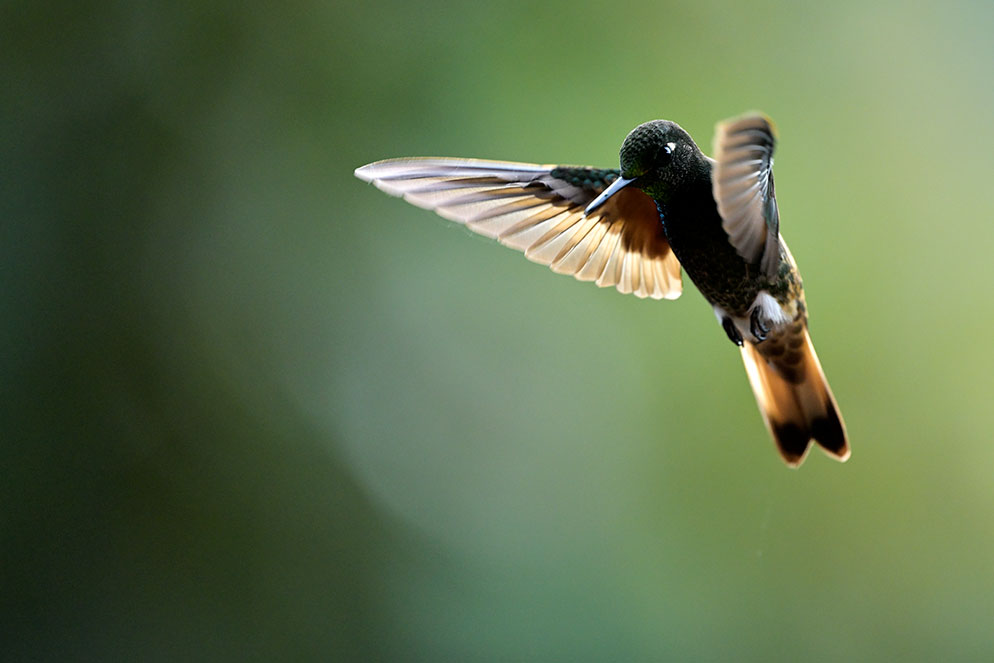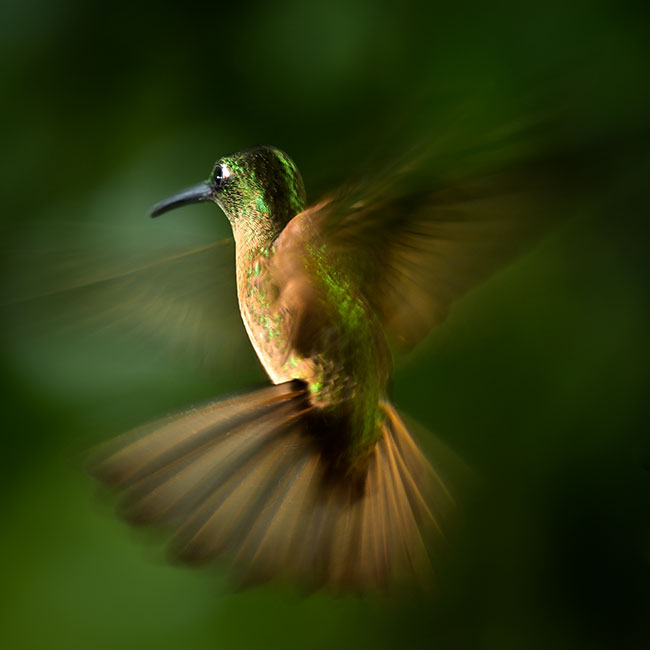The Big Reveal: How the Power of Emotion Creates Compelling Images of Nature
Capturing wildlife with the NIKKOR Z 400mm f/2.8 VR S lens
The beautiful colors of the hummingbird and its habitat were the attraction here, the eye contact a bonus. With the NIKKOR Z 400mm f/2.8 TC VR S’s 1.4x built-in teleconverter switched on, the effective focal length was 560mm. Z 9, NIKKOR Z 400mm f/2.8 TC VR S, 1/250 second, f/5.6, ISO 1600, manual exposure.
Great wildlife photography is a revelation.
Kristi Odom knows that. She strives for images that reveal beyond what the eye can see, and as a result her stills and videos show something of the image-maker as well: a dedication and determination to communicate to others how deeply she cares about her subjects, and how much she wants to inspire that feeling in others.
What came across instantly when we viewed her stunning birds-of-Ecuador video was the compelling beauty of her storytelling art. We were fascinated by what she was showing us—and so was she. “It’s hard to put into words what I felt when I saw the hummingbirds,” she says. “They were so full of color, movement, personality and behaviors. They fascinated me, and I was thankful to have a wonderful opportunity to be able to explore that fascination.”
Birds of Ecuador - The extraordinary capabilities of the Z 9 and the NIKKOR Z 400mm f/2.8 TC VR S lens provide Kristi Odom a way of expressing—and sharing—her connection with nature. Don’t miss this!
A Deeper Understanding
The simple truth of it is that nature has given so much to Kristi that in her photography there’s an element of giving back by inspiring viewers of her images to share her awareness, her respect and her concern for her subjects. “I find so much grandeur and so much of the sublime in nature that I need to share my appreciation, understanding and concern with others,” she says. “I feel there’s a deep connection and a calling I’ve had from nature that makes me want to help protect it.”
Part of what nature gives her is a sense of peace and purpose. “When I’m looking through the camera, all the noise of the world disappears—the news, the stories, the stress and insecurities—and I’m left to photograph the pure instances of the beauty I see. I feel that photography and videography help me develop a deeper connection with nature, and I can record my emotions and responses, and hopefully evoke emotion in the viewer.”
“Usually there’s lots of diffused light in Ecuador’s cloud forests, but this day there was bright sunlight,” Kristi says. “I exposed for the highlight hitting the toucan—which brought a lot of darkness into the image, but if I hadn’t, the beak would have been blown out.” Z 9, NIKKOR Z 400mm f/2.8 TC VR S (1.4x teleconverter on), 1/1600 second, f/6.3, ISO 160, manual exposure.
Portrait of the toucan whose chest close-up is a striking moment in the video. Z 9, NIKKOR Z 400mm f/2.8 TC VR S (1.4x teleconverter on), 1/320 second, f/4, ISO 800, manual exposure.
I feel that photography and videography help me develop a deeper connection with nature.
A hummingbird in early morning light. Z 9, NIKKOR Z 400mm f/2.8 TC VR S, 1/1250 second, f/2.8, ISO 2000, manual exposure.
Decisive Moments
To make that level of communication possible—to capture in images the distinct, varied moments and activities that carry the emotional power of her subjects—takes observation, insight and total command of tools and techniques.
The use of slow motion is a frequent choice in order to reveal details of the subjects’ reactions to the world around them, those descriptive and dramatic views the human eye can’t perceive.
Shooting wide open produces practical advantages. “I like a shallow depth of field to separate the subject from background,” Kristi says, “and I also want higher shutter speeds in order to stop the motion of wings in the air.”
And significantly, the use of the NIKKOR Z 400mm f/2.8 lens, with its built-in 1.4x teleconverter, extends its reach to 560mm to capture detailed still and video images while Kristi remains at a distance from her subjects.
That latter consideration—photography with care and respect—is always a prime factor. “I talked to a lot of experts in doing my research to make sure I wasn’t disturbing the birds,” Kristi says. Because the lodges at which she photographed have hummingbird feeders, she checked with a friend in the Audubon Society to ask about the ethics of photographing at or near feeders. It’s deemed okay, she says, “as long as the resorts and hotels do daily feeder cleanings to be sure they’re not transmitting diseases or attracting ants or wasps. The Audubon Society has ethical guides for birding photography, and I went through everything to make sure what I was doing was okay.”
The ethics of wildlife photography include not influencing or deliberately trying to attract attention. “The birds’ reactions are all natural,” Kristi says. “They’re hyper aware, and though I did my best to be as quiet as possible, they could hear me, from my breathing to prepping a tripod or monopod, but they’re not threatened. Ecuador is a birding hotspot; it’s not a place where humans threaten birds.”
Kristi knows that if anything is manipulated, or if the wildlife is disturbed or prompted into movement or action, she would not be portraying what is real—which, after all, is why she’s there: to communicate with honesty, care and respect the beauty she observes.
Kristi used a constant backlight and a remotely-fired, off-camera SB-5000 Speedlight at camera left to create this glowing image. A slow shutter speed allowed the blur of wing movement; rear-curtain sync fired the flash at the end of the exposure to keep the bird’s body sharp. “I put the flash at an angle so that it would make the colors pop and bring out their metallic look.” Z 9, NIKKOR Z 400mm f/2.8 TC VR S, 1/20 second, f/6.3, ISO 250, manual exposure.
BTS: Birds of Ecuador - Join Kristi Odom in the cloud forests of Ecuador for a behind-the-scenes look at how she created the incredible stills and video you see in her video. (A lens that reaches beyond the ordinary had something to do with it.)










